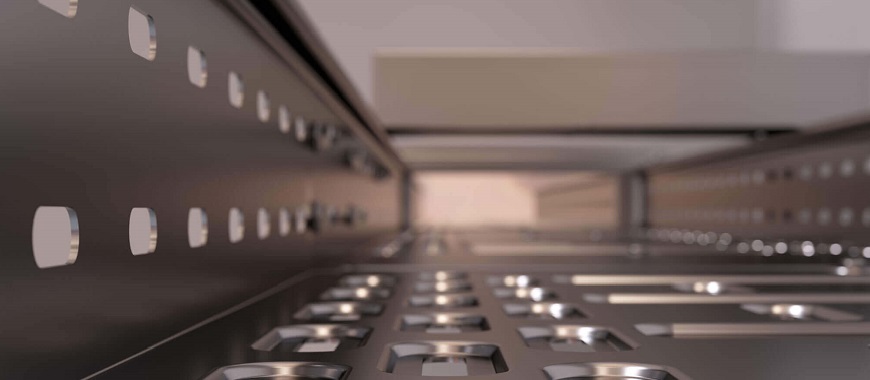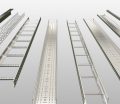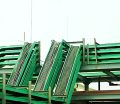
Marine cable trays are essential components for managing cables in harsh maritime environments. Designed to withstand challenging conditions, these trays ensure safety and efficiency in cable organization. Their use is common in ships, offshore platforms, and industrial facilities exposed to moisture and corrosion.The durability of marine cable trays is attributed to their resistance to caustic substances and harsh weather. They play a vital role in protecting cables from damage while simplifying maintenance. Multiple types, including fiberglass and metal trays, are available to meet diverse needs.Selecting the right marine cable tray involves understanding factors such as material, size, and compliance with safety standards. This ensures optimal performance and longevity in demanding applications.
Everything You Need to Know About Marine Cable Tray
The Role of Marine Cable Tray in Modern Cable Management
Marine cable trays are crucial for efficient cable organization in marine and offshore environments. These trays are specifically designed to handle the unique challenges posed by maritime settings, ensuring that cables remain secure, accessible, and protected. Their use is widespread across ships, offshore platforms, and industrial environments, where exposure to harsh weather and corrosive substances is common.
Proper cable management is vital for safety and operational efficiency. Marine cable trays streamline the organization of electrical and communication cables, reducing the risk of accidents or failures. By providing structural support and protection, they enhance the lifespan and functionality of the installed systems.
Key Features of Marine Cable Trays
- Corrosion Resistance: Essential for environments exposed to saltwater and moisture, ensuring long-term durability.
- High Load Capacity: Designed to support significant cable weight without compromising structural integrity.
- Ease of Installation: Modular designs allow for flexibility during setup, reducing installation time and costs.
- Versatility: Suitable for various cable types, including electrical, communication, and data cables.
- Compliance: Meets strict industry standards for safety and performance in marine environments.
Applications of Marine Cable Trays
Marine cable trays are indispensable in:
- Ships: Manage power distribution, lighting, and communication systems efficiently.
- Offshore Platforms: Support complex networks of cables for drilling, communication, and energy systems.
- Industrial Settings: Ensure reliable cable management in facilities near coastal areas.
Choosing the Best Cable Tray Feet for Support
Exploring Marine Grade Cable Tray for Harsh Environments
What is a Marine Grade Cable Tray?
Marine grade cable trays are engineered for exceptional durability in the face of challenging environmental conditions. These trays are built with materials that resist corrosion, extreme temperatures, and mechanical stress, ensuring reliable performance over time.
Characteristics of Marine Grade Cable Trays
- Material Composition: Often constructed from stainless steel, aluminum, or fiberglass for enhanced resilience.
- Structural Integrity: Designed to endure heavy loads and physical impact without deforming.
- Protective Coatings: Includes anti-corrosion treatments or finishes for prolonged durability.
- Weather Resistance: Capable of withstanding continuous exposure to saltwater, UV rays, and high humidity.
- Adaptability: Available in various sizes and configurations to suit specific installation requirements.
Benefits of Using Marine Grade Cable Trays in Corrosive Environments
- Extended Lifespan: Reduces replacement frequency, leading to cost savings over time.
- Safety Assurance: Prevents damage to cables that could lead to electrical hazards.
- Maintenance Efficiency: Simplifies access for inspections and repairs, lowering maintenance costs.
- Environmental Compliance: Meets stringent regulations for use in sensitive marine ecosystems.
- Versatile Applications: Suitable for multiple settings, from shipboard installations to industrial facilities.
Applications of Marine Grade Cable Tray in the Maritime Industry
Marine cable trays play a pivotal role in supporting maritime operations.
- Offshore Platforms: Essential for cable management in energy production and drilling operations, where exposure to corrosive environments is unavoidable.
- Commercial Shipping: Supports communication and navigation systems, ensuring reliable connectivity.
- Fishing Vessels: Protects electrical systems from moisture and physical damage.
- Naval Vessels: Facilitates secure cable management for defense and operational systems.
- Marine Industrial Facilities: Ensures efficient and safe cable routing in coastal plants and terminals.
Features and Benefits of Marine LSZH Cable Tray
Introduction to Marine LSZH Cable Tray
Marine LSZH (Low Smoke Zero Halogen) cable trays are specifically designed to enhance safety in marine applications. The materials used in these trays emit minimal smoke and toxic gases when exposed to fire, making them ideal for confined spaces.
Benefits of LSZH Materials
- Fire Safety: Reduces smoke production, improving visibility and safety during evacuation.
- Toxicity Reduction: Emits fewer harmful gases, protecting personnel and sensitive equipment.
- Durability: Resistant to corrosion and chemical damage.
- Eco-Friendly: Minimal environmental impact due to halogen-free composition.
- Compliance: Meets stringent safety standards for marine and industrial applications.
Why Marine LSZH Cable Tray is Essential
Marine LSZH cable trays are indispensable in safety-critical marine installations.
- Enhanced Safety During Fire Incidents:
LSZH trays are designed to limit the spread of fire, reducing the risk of catastrophic damage. In enclosed marine environments, the absence of harmful smoke ensures safer evacuation and protection for onboard systems. - Applications in Confined Spaces:
These trays are particularly useful in ship cabins, control rooms, and industrial spaces where fire hazards are a concern. By minimizing toxic emissions, they safeguard both human life and operational equipment.
Marine cable trays, including marine grade and LSZH varieties, are essential components for maintaining efficient and safe cable management in harsh maritime environments. Their durability, safety features, and adaptability make them invaluable across ships, offshore platforms, and coastal industrial facilities. Whether managing cables in corrosive conditions or ensuring safety in fire-prone areas, marine cable trays play a pivotal role in supporting modern maritime and industrial operations.
Rooftop Cable Tray Sizes and Installation Guidelines Explained
Marine Cable Tray Sizes: Choosing the Right Dimensions
Overview of Standard Sizes and Configurations
Marine cable trays are available in various sizes and configurations to accommodate different cable management needs. Standard sizes typically range in width, height, and length to ensure flexibility in installations. Tray widths commonly range from 50mm to 600mm, while depths can vary from shallow 25mm designs to deeper 150mm options. Lengths are standardized to optimize ease of handling and installation, often spanning 3 to 6 meters.
Different configurations include:
- Ladder-Type Trays: Designed for high ventilation and easy access during cable maintenance.
- Solid-Bottom Trays: Suitable for cables requiring extra protection against external elements.
- Channel Trays: Compact and ideal for single cable runs in confined spaces.
- Wire-Mesh Trays: Lightweight and easy to install, commonly used for smaller cable bundles.
Factors to Consider When Selecting the Appropriate Size for Specific Applications
Choosing the right marine cable tray size requires careful evaluation of specific installation needs. Key factors include:
- Cable Volume: Determine the tray width based on the number and size of cables being routed. Overcrowding can lead to heat buildup and operational inefficiency.
- Weight Support: Ensure the tray can handle the total cable weight without sagging. Fiberglass options from GangLong Fiberglass provide excellent load capacity with minimal weight.
- Environmental Conditions: Assess exposure to corrosive elements, moisture, or extreme temperatures to choose materials and coatings appropriately.
- Space Constraints: Consider the available space in the installation area, especially in ship cabins or industrial facilities with limited clearance.
- Future Expansion: Opt for sizes that allow for additional cables in future installations to reduce the need for replacement.
Best Marine Cable Tray for Different Applications
Criteria for Determining the Best Marine Cable Tray
Selecting the best marine cable tray depends on several critical criteria:
- Durability: Materials like fiberglass or stainless steel ensure longevity in harsh conditions. Fiberglass trays resist corrosion, making them ideal for marine environments.
- Compliance: Ensure trays meet international safety and performance standards, such as NEMA or ABS. Compliance guarantees suitability for demanding applications.
- Design Flexibility: Modular systems simplify installation and allow customization for unique layouts.
- Load Capacity: Choose a tray that can support the cable weight without compromising structural integrity.
- Cost-Effectiveness: Evaluate the long-term cost benefits of durable materials over cheaper, less reliable options.
Fiberglass Marine Cable Tray: A Durable Solution for Marine Use
Advantages of Fiberglass Cable Tray in Marine Environments
Fiberglass marine cable trays offer numerous advantages, making them a preferred choice for demanding applications.
- Corrosion Resistance: Fiberglass is naturally resistant to saltwater and harsh chemicals, ensuring longevity in marine settings. This resistance significantly reduces maintenance costs and prevents structural degradation.
- Lightweight Design: Fiberglass trays are lighter than metal alternatives, simplifying transportation and installation without compromising strength. This feature also reduces the overall load on supporting structures.
- High Strength-to-Weight Ratio: Despite being lightweight, fiberglass offers exceptional strength, making it capable of handling heavy cable loads effectively.
- Electrical Insulation Properties: Fiberglass is a non-conductive material, providing inherent safety against electrical hazards. This is particularly beneficial in installations where electrical interference must be minimized.
- Eco-Friendly Manufacturing: GangLong Fiberglass produces trays using sustainable practices, ensuring environmental compliance and reduced carbon footprint.
Understanding Fiberglass Cable Tray Price
Several factors influence the price of fiberglass marine cable trays.
- Size: Larger trays require more materials, increasing their cost. However, bulk purchasing often provides cost savings.
- Design: Custom configurations or specialized designs may carry a premium but offer better functionality.
- Material Quality: High-grade fiberglass costs more initially but offers better durability and long-term savings.
- Coatings and Treatments: Additional anti-corrosion coatings or fire retardant treatments can add to the price.
- Supplier Reputation: Established manufacturers like GangLong Fiberglass provide reliable, cost-effective options with quality assurance.
Cost Benefits of Fiberglass Marine Cable Trays:
- Reduced maintenance expenses due to corrosion resistance.
- Long lifespan compared to traditional materials like steel.
- Lightweight nature lowers transportation and installation costs.
NEC Cable Tray Fill Requirements: A Comprehensive Guide
Leading Marine Cable Tray Manufacturers and Their Offerings
Overview of Prominent Marine Cable Tray Manufacturers
The marine cable tray industry is supported by manufacturers focusing on innovation, quality, and compliance. GangLong Fiberglass stands out as a trusted provider of fiberglass trays for marine and industrial applications. Their offerings include ladder-type, solid-bottom, and wire-mesh configurations, catering to diverse needs.
Factors to Consider When Selecting a Manufacturer:
- Experience: Opt for manufacturers with proven expertise in marine cable management systems.
- Quality Standards: Ensure products meet international standards like NEMA, ABS, and ISO certifications.
- Customization Options: Choose manufacturers that offer tailored solutions for unique project requirements.
- After-Sales Support: Reliable customer service and maintenance support are essential for long-term satisfaction.
- Sustainability: Prefer manufacturers committed to eco-friendly practices and sustainable material sourcing.
NEMA Cable Tray: Standards for Marine Installations
Overview of NEMA Standards for Cable Trays
NEMA (National Electrical Manufacturers Association) sets rigorous standards for cable trays to ensure their performance and safety. NEMA classifications specify load capacity, material strength, and environmental resistance, making them critical benchmarks for marine cable tray selection.
Key NEMA Classifications:
- NEMA 20A: Light-duty trays suitable for low-cable loads.
- NEMA 12C: Standard-duty trays for general industrial applications.
- NEMA 16D: Heavy-duty trays designed for high-load installations.
Importance of Compliance with NEMA Specifications in Marine Applications
Compliance with NEMA standards ensures:
- Safety: Trays are designed to handle specific load capacities, reducing the risk of structural failure.
- Reliability: NEMA-compliant trays perform consistently in harsh conditions, ensuring uninterrupted operations.
- Global Compatibility: Meeting NEMA specifications aligns products with international installation requirements.
- Long-Term Value: Certified trays last longer, offering better value over time.
- Peace of Mind: Clients trust products that meet recognized safety and quality standards.
Marine cable trays are indispensable for ensuring efficient and safe cable management in demanding environments. From selecting the right size to understanding the advantages of fiberglass materials, careful planning ensures long-term success. By considering factors like compliance, material quality, and design flexibility, industries can rely on marine cable trays to enhance operational efficiency and safety. With trusted providers like GangLong Fiberglass, durable and high-performance solutions are readily available for all marine applications.
FAQs about Marine Cable Tray
The three main types of cable trays are ladder-type, solid-bottom, and wire-mesh trays.
Ladder-type cable trays have two side rails connected by rungs. They provide excellent ventilation and allow heat to dissipate efficiently. This type is ideal for power cables and large wiring bundles where airflow is essential.
Solid-bottom cable trays have a flat, continuous surface that protects cables from external elements. They are commonly used for cables requiring enhanced shielding or protection from debris, water, or other environmental factors.
Wire-mesh cable trays consist of a lightweight metal grid structure. They are ideal for smaller cables or confined spaces, offering flexibility and easy installation while maintaining cable organization.
Each type is designed to suit specific environments and requirements, making them versatile for different industries, including marine applications.
Marine cables are specially designed to withstand harsh maritime environments, unlike normal cables used in standard installations.
Marine cables are resistant to moisture, saltwater, and corrosive substances, ensuring longevity in tough conditions.
They are built with high-grade insulation materials, reducing the risk of electrical failures caused by water ingress or corrosion.
Many marine cables comply with low smoke zero halogen (LSZH) standards, enhancing safety during fire incidents by emitting less toxic smoke.
Normal cables lack these protective features, making them unsuitable for marine or offshore environments.
Marine cables often have superior mechanical strength, allowing them to withstand vibrations and mechanical stress found on ships or offshore platforms.
This distinction ensures marine cables meet the safety and performance requirements of maritime applications.
Cable tray supports are typically spaced based on the tray’s load capacity and design specifications.
For ladder-type trays, supports are usually installed 1.5 to 3 meters apart, depending on the tray’s material and expected load.
Solid-bottom trays may require closer support spacing, typically around 1.2 to 2 meters, to prevent sagging due to their design.
Wire-mesh trays often have support spacing of about 1 to 1.5 meters, as their lightweight structure benefits from frequent support.
Factors like cable weight, installation environment, and local regulations influence support placement.
Proper support spacing ensures stability, prevents sagging, and maintains the tray’s structural integrity over time.
Consulting the manufacturer’s guidelines is crucial for determining the optimal support distances for specific applications.
Cable trays are often considered more cost-effective than conduit systems for cable management.
Cable trays require fewer materials and installation steps, reducing initial costs compared to conduits.
The open design of cable trays allows easier cable installation, reducing labor time and costs significantly.
Maintenance is simpler with cable trays, as cables are easily accessible, unlike enclosed conduits that may require dismantling for repairs.
Conduit systems are more expensive for large-scale projects due to the need for additional materials and fittings.
While conduits may offer better protection in some environments, cable trays provide flexibility and scalability, which can result in long-term savings.
For marine and industrial settings, cable trays are a preferred option due to their efficiency and cost advantages.

As the editor of GangLong Fiberglass, I have years of experience and in-depth research, focusing on cable tray products, fiberglass solutions, and grille systems. I incorporate years of industry insights and practical experience into every content, committed to promoting the progress of the industry. At GangLong Fiberglass, my commitment is reflected in every product, from innovative cable trays to durable fiberglass solutions and sturdy grille systems. As an authoritative voice in the industry, my goal is to provide valuable information to professionals and businesses and promote forward-looking solutions.


